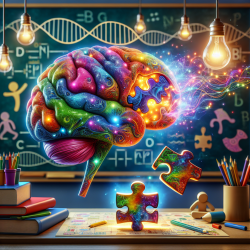Introduction
The intersection of autism and high intelligence presents a fascinating paradox that challenges conventional understanding. While autism is often associated with below-average IQ, recent research suggests a significant genetic overlap with high intelligence. This blog explores how practitioners can leverage these insights to enhance their skills and improve outcomes for students with autism.
Understanding the Paradox
Bernard J. Crespi's research article, "Autism As a Disorder of High Intelligence," posits that autism involves enhanced, albeit imbalanced, components of intelligence. The study highlights that alleles for autism risk overlap significantly with those for high intelligence, suggesting that autism may involve dysregulated intelligence rather than a straightforward deficit.
Implications for Practitioners
For practitioners, understanding this genetic and cognitive overlap can inform more tailored interventions. Here are some strategies to consider:
- Focus on Strengths: Identify and nurture the enhanced cognitive abilities in students with autism, such as visual-spatial skills and attention to detail.
- Individualized Education Plans (IEPs): Develop IEPs that incorporate tasks and activities that align with students' strengths, promoting engagement and learning.
- Encourage Systemizing Skills: Leverage the natural inclination towards systemizing in autism to foster interests in STEM fields, where these skills are highly valued.
- Balance Cognitive Components: Aim to balance enhanced abilities with areas that require development, such as verbal skills, through targeted interventions.
Encouraging Further Research
Practitioners are encouraged to delve deeper into the genetic and cognitive underpinnings of autism and intelligence. By integrating findings from evolutionary biology, neuroscience, and psychology, new therapeutic approaches can be developed to address the unique cognitive profiles of students with autism.
Conclusion
Understanding autism as a disorder of high intelligence offers a new lens through which practitioners can view and support their students. By focusing on strengths and addressing imbalances, educators can foster a more inclusive and effective learning environment.
To read the original research paper, please follow this link: Autism As a Disorder of High Intelligence.










